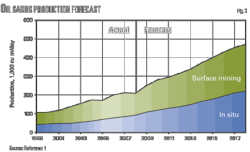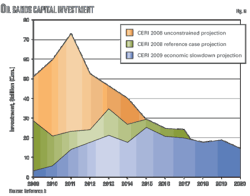Back-propagation network simplifies energy-use prediction
A back-propagation neural network can easily predict the energy consumption of a pipeline system with fewer mathematical statistics than other methods and a simple pretreatment of the original data.
The energy consumption prediction uses different nonlinear influence factors by learning the operation data of a certain pipeline via the BP neural network. Calculated results show a prediction error within 5%, capable of satisfying engineering demand.
No uniform selection criterion exists for the number of nodes in the latent layer. The selection of a latent layer and its number of nodes, however, do influence the degree of nonlinear error and therefore need further study.
The prediction uses actual pipeline operation data and therefore will only improve as more data are monitored and recorded and more influence factors emerge.
Background
Fuel oil and electricity consumption account for most of pipeline operating costs. Improving efficiency requires analysis of energy consumption trends and identification of the weak links in energy utilization. Energy consumption prediction for pipeline systems remains an immature science despite considerable research.
One proposed energy-consumption prediction model applies regression treatment to a pipeline's operation data.1 Computations using the regression method, however, are lengthy and its prediction accuracy is low. It also is incapable of predicting energy consumption at any chosen throughput point.
The gray theory method needs fewer samples, simple calculations, and has a wide range of application. Its accuracy, however, is not ideal because it only considers throughput even though many factors can affect a pipeline's energy consumption.2
An artificial neural network (ANN) model belongs to a latent-formula model and is capable of self-organizing, self-adaptability, and self-learning.3-4 BP neural network is a supervised training, multi-layer back-propagation neural network. It can perform discretionary nonlinear mapping.
The relation between a pipeline system's energy consumption, its facilities, and operating scheme is complicated.5-9 This article describes the mapping relation between energy consumption and different factors, including throughput, as simulated by BP neural network for the Zhong-Luo oil pipeline.
Thermal energy
Equation 1 defines effective heat load at an oil transport station. Equation 1 shows the energy needed to heat oil depends on throughput, oil density, specific heat capacity, and the difference between inlet temperature and outlet temperature at the oil transport station.
Oil density and specific heat capacity vary slightly as temperature changes and can thus be calculated at the average temperature. Changes in temperature difference at the oil transport station and operation data can be processed monthly to guarantee the soil temperature is unchanged or changes only slightly.
Temperature at the inlet and outlet of each oil transport station decreases as the throughput of the pipeline increases. The difference between inlet temperature and outlet temperature of the oil transport station is a function of oil throughput. Throughput affects thermal consumption and should be considered among the influence factors when establishing the BP neural network prediction model of oil consumption for unit oil pipeline transportation turnover volume (OCUOPTTV).
Thermal consumption increases with the increasing outlet temperature for certain oil pipelines. Considering the influence of the sum of the temperature difference between the inlet and outlet for every oil transport station (STDBIO) on the prediction model allows consideration of outlet temperature.
The difference between the oil temperature and soil temperature can affect thermal consumption. The sum of the temperature difference between the oil and the soil around the pipeline (STDBOS) therefore acts as one of the influence factors of the predictive model.
Electricity consumption
Electricity is mainly consumed to overcome pump pressure drop. Equation 2 expresses frictional loss of an oil pipeline.
Equation 2 shows the electricity consumption of an oil pipeline as mainly related to pipeline throughput and oil kinematic viscosity. Oil kinematic viscosity can be calculated at the average temperature.
The absence of data addressing oil kinematic viscosity in the operation report table, however, excludes consideration of the oil kinematic viscosity for certain oil pipelines when establishing the BP neural network prediction model. Electricity consumption is instead related to throughput directly, and throughput should be regarded as an influence factor when establishing the BP neural network's prediction model for electricity consumption of unit oil pipeline transportation turnover volume (ECUOPTTV).
The outlet temperature of the oil transport station can affect electricity consumption of the pipeline indirectly. The oil's kinematic viscosity decreases as the outlet temperatures rise. The friction loss increases as kinematic viscosity is decreased, resulting in greater electricity consumption. Including the STDBIO as one of the influence factors of the prediction model allows consideration of the outlet temperature for every transport station.
The oil pump's electricity consumption is also related to the oil transport station's outlet pressure. Electricity consumption increases with outlet pressure. Considering the outlet pressure of each oil transport station requires using the sum of the pressure difference between the inlet and outlet for every oil transport station (SPDBIO) as one of the influence factors of the prediction model.
OCUOPTTV, ECUOPTTV, and the comprehensive energy consumption measured as unit oil pipeline transportation turnover volume (CECUOPTTV) are the widely used indexes in statistical analysis of energy consumption by pipeline systems. The above analysis treats throughput, STDBOS, STDBIO, and SPDBIO as the main factors influencing the pipeline system's energy consumption.
BP network
Kolmogorov theory states a three-layer BP network can approach discretionary continuous nonlinear mapping.10 The three layers consist of an input layer, latent layer, and output layer.
The input layer receives the external data, the latent layer processes and converts the input data, and the output layer produces the output. Interconnection occurs among layers and the nodes in the same layer have no connection. The number of variables, such as energy consumption influence factors and energy consumption indicators, determines the number of nodes in the input and output layers. The node quantity of the latent layer is confirmed by trial and error.
The essential step in BP neural network modeling therefore is determining how to confirm the node number. The latent layer nodes express the nonlinearity between the network's input and output. Selection of a latent layer and its number of nodes influences the nonlinear error between the predictive and actual values.
Increasing the number of latent layer nodes can increase the adjustable parameters of the nonlinear optimizing problem, strengthen the memory of the network, and yield a more accurate result, but it debases the study speed of the network. Too few latent layer nodes can cause the network to converge to its partial minimum. Experiment and experience yield the correct number of latent layer nodes.
Throughput, STDBOS, STDBIO, and SPDBIO act as the target output for constructing the three-layer BP neural network's energy-consumption prediction models: OCUOPTTV, ECUOPTTV, and CECUOPTTV. Fig. 1 shows the prediction model of OCUOPTTV having three layers of input—throughput, STDBOS, and STDBIO—and one of output, OCUOPTTV. The prediction model of the ECUOPTTV (Fig. 2) has the same structure, with SPDBIO replacing STDBOS as the input layer and ECUOPTTV replacing OCUOPTTV as the output layer. CECUOPTTV's prediction model (Fig. 3) has four nodes in the input layer, throughput, the STDBOS, STDBIO, and SPDBIO. The output layer is the CECUOPTTV.
Pipeline system
The Zhong-Luo oil pipeline's energy consumption served as a prediction example. This pipeline is 282 km long, originating at the Zhongyuan oilfield and ending at Luoyang oil refinery. The line includes six pump (transport) stations.
Analysis used the pipeline's operating data for January 2006, consisting of 31 groups of data. Twenty-five of these served as the study samples for network analysis (Table 1). Avoiding the negative effects of the absolute size of the data on the results, the method expressed in Equation 2 normalized treatment of input and output data.11
The study method already detailed trained the network. Studying the samples allowed for adjustment of the network's weight and bias. The nonlinear relation between different influence factors and pipeline energy consumption entered the network continuously and was stored to weight the network.
The artificial neural network recorded the complicated nonlinear relation of the object function between different influence factors and pipeline energy consumption according to the number matrix of the weight. The network realized discretionary nonlinear mapping from input mode to output mode and predicted energy consumption under the effects of many uncertain factors in different conditions.
Matlab programmed the corresponding calculation process using its neural network toolbox, integrating a wide range of learning algorithms. Calling function trainlm trained the network. Hyperbolic tangent function tansig is the transformation function in the latent layer, purelin is the transformation function in the output layer. Repeated testing determined the numbers of nodes in the latent layer of each model as 7, 10, and 7, respectively, producing a better prediction result.
Prediction model
The model calculation consists of input signal forward-propagation and error signal back-propagation. In forward-propagation, the input signal moves from input layer to output layer, layer by layer. The neurons in the output layer respond to the input mode.
Adaptive learning requires changes in the training procedure used by trainlm. These include first calculating the initial network output and error. At each epoch the current learning rate calculates new weights and biases, which it then uses to calculate new outputs and errors. If new errors are fewer than in the previous iteration, calculation ceases. If new errors expand, back-propagation occurs until new errors are less than old errors.
Network testing must follow training. The test uses a simulated function to obtain network output and check whether the deviation between the predicted value and the actual value meets requirements. The tested samples in Table 2 trained the BP network after initialization treatment, producing corresponding output values from the now trained network.
The system compared the predicted value and the actual value. If errors are within required levels the network is available if not it must be trained again.6
The previously discussed network predictive models forecast pipeline energy consumption. Tables 3-5 show the calculated results. The tables show the average relative deviation range between predicted and actual values as <5% in all cases: 1.49%, 2.74%, and 4.28% respectively.
Fig. 4 shows the contrast curves between predicted and actual values. The units of OCUOPTTV, ECUOPTTV, and CECUOPTTV are kg/(104 tonne∙km), kW∙hr/(104 tonnne∙km), and kg coal equivalent/(104 tonne∙km), respectively. This method indirectly considers almost all the influence factors affecting the pipeline's energy consumption.
Deviation analysis
Three factors cause the deviation between predicted value and actual value. Energy consumption data cannot reflect actual operating conditions exactly. Using only the four available influence factors reduces the model's abilities. Determining the number of latent layer nodes by repeated testing led to some systematic errors.
References
1. Li, Y.C., "Prediction and Analysis on the Statistics of Oil Pipeline Throughput and Oil and Power Consumption," Oil & Gas Storage and Transportation, Vol. 9, No. 5, pp. 62-66 (in Chinese), October 1990.
2. Sui, F.J., Wu, M., and An, B.W., et al., "Gray Model of Consumption on Electricity and Fuel Oil of Oil Pipeline and Forecasting," Nature Gas & Oil, Vol. 21, No. 4, pp. 10-12 (in Chinese), August 2003.
3. Li, L.R., and Jiao, L.C., "Prediction of the Oilfield Output under the Effects of Nonlinear Factors by Artificial Neural Network," Journal of Xi'an Petroleum Institute, Vol. 17, No. 4, pp. 42-44 (in Chinese), August 2002
4. Yu, S.L., and Gao, H., "Predicting of Cement Strength Based on Neural Network," Journal of Hefei University of Technology, Vol. 25, No. 2, pp. 316-320 (in Chinese), April 2002.
5. Zhang, Q., Liu, M., and Ling, Z.H., et al., "Design of Energy Consumption Prediction System of Iron and Steel Enterprises," Metallurgical Power, No. 2, pp. 67-70 (in Chinese), April 2006.
6. Han, Q.H., Jin, Y.L., and Zhang, J.H., "Application of Neural Networks in the Prediction of Solid Fuel Consumption in Sintering Process," Energy For Metallurgical Industry, Vol. 24, No. 2, pp. 9-11 (in Chinese), April 2005.
7. Zheng, H.C., Li, H.Y., and Jia, L.X., "Calculation of Phase Equilibrium for CO2-MDEA-PZ-H2O System Based on BP Artificial Neural Network," Energy Conservation Technology, Vol. 26, Vo. 3, pp. 226-227 (in Chinese), June 2008.
8. Alireza, K., Reza, A.R., and Lu, T.L., et al., "Neural Network Based Electric Load Forecasting System," IEEE Transactions on Neural Networks, Vol. 8, No. 4, pp. 835-845, August 1997.
9. Yutaka, F., Hideo, M., and Haruyuki, M., et al., "A Modified Back Propagation Method to Avoid False Local Minima," Neural Networks, Vol. 11, No. 6, pp. 1059-1072, December 1998.
10. Zhang, J., Xing, C.C., and Yue, X.D., "Application of Neural Network to Predicting Nitrogen Content," Journal of Liaoning Institute of Technology, Vol. 20, No. 2, pp. 1-3 (in Chinese), April 2000.
11. Zhou, K.L., and Kang, Y.H., "Neural Network Model and MATLAB Simulation Program Design," Beijing, Tsinghua University Press, pp. 55-60 (in Chinese), January 2005.
The authors











